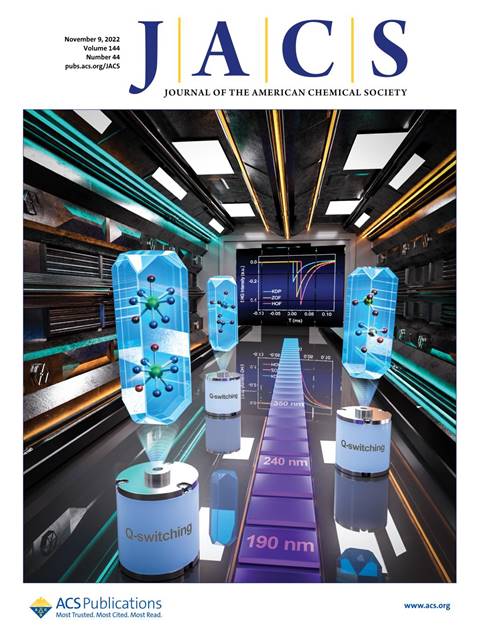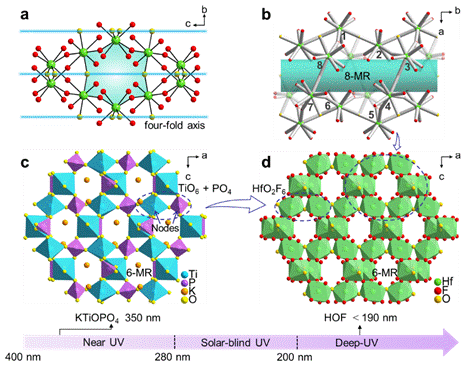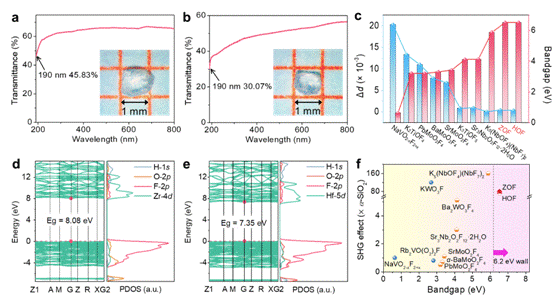Zhang Chi's research team has achieved a strong second-harmonic generation in deep-ultraviolet transition metal oxyfluoride for the first time.Deep-ultraviolet (λ < 200 nm) second-order nonlinear optical materials, widely applied in the fields of high-power ultrashort pulse laser output, preparation of entangled photon source, short-wave communication, 193 nm photoetching, and vacuum ultraviolet laser angle-resolved photoemission spectroscopy (ARPES), are a key scientific and technological bottleneck hindering advanced laser manufacturing technology and process. It's reported that deep-ultraviolet nonlinear optical crystals currently available on the market are hard to satisfy the efficient wavelength conversion of ultraviolet, especially deep ultraviolet, due to their structural defects or phase mismatch, which greatly impedes the rapid development of modern laser crystal technology and its practical application in high-tech fields. For this concern, the creation and R&D of second-order nonlinear optical crystal materials with a wide light transmission range in the UV band, a large SHG response, and capable of phase matching is a very challenging scientific and technical problem confronted in the fields of high-performance optical materials and the modern optical communication.

The research team of Professor Zhang Chi, Academician of the European Academy of Sciences and Dean of the School of Chemical Science and Engineering, Tongji University, proposed an "isoreticular design" strategy by studying d0transition metal oxyfluoride and created the first deep-ultraviolet transparent d0transition metal oxyfluoride crystalline material MOF4H2 (M = Zr (ZOF), Hf (HOF)), with the physical mechanism that the oxyfluoride achieves the synchronous gain of bandgap and SHG response discussed and illustrated. The achievement "Isoreticular Design of KTiOPO4-like Deep-Ultraviolet Transparent Materials Exhibiting Strong Second-Harmonic Generation" was published as an Article today in theJournal of the American Chemical Society(2022, 144(44), 20394-20399), the most important academic journal in the global chemistry field and was selected by the JACS Editorial Board as the cover article of the latest issue considering the significant innovation of its research work and high recognition of peer experts.

In this study, the research team unprecedentedly presented an "isoreticular design" strategy, in which, they took potassium titanyl phosphate KTiOPO4(KTP), a famous commercialized second-order nonlinear optical crystal, as the structural model, and replaced [TiO6] and [PO4] in the classical KTP structure with d0transition metal central primitives [MO2F6] (M = Zr, Hf) featuring a lower effective electronegativity by changing the types of transition metal polyhedral primitives for functional network nodes in the KTP three-dimensional structure, to create the first d0transition metal oxyfluorides ZOF and HOF with a KTP-like structure. Compared with transition metal [TiO6] polyhedral primitives, the central primitives of transition metal zirconium/hafnium cations in ZOF and HOF have a higher oxygen-fluorine ratio; compared with high-valence transition metal polyhedral primitives, the zirconium/hafnium cations of tetravalent d0 transition metal have a lower effective electronegativity, capable of effectively blocking the charge transfer between oxygen/fluorine and metal in the metal polyhedron. The introduction of fluorine atoms with the highest electronegativity into such metal polyhedrons and the possible increase of the F/O ratio in the metal polyhedrons can dramatically change the electronic band structure of the material, providing a great possibility for its blue shift of the UV absorption cutoff. Above all, the long-range well-organized microscopic arrangement of the d0transition metal central polyhedrons allows the material to exhibit a strong second harmonic effect.

The research team also carried out simulation calculations with single-crystal X-ray diffraction analysis in combination with the first principle theory to further explore and clarify that the maximum gains of band gaps in ZOF and HOF can be attributed to the high fluorination of the d0transition metal polyhedron [MO2F6] (M = Zr, Hf) primitives and the low electronegativity at the metal center. According to the experimental results, both ZOF and HOF show good physicochemical stability and have a UV absorption cutoff smaller than 190 nm. This oxyfluoride exhibits a strong powder SHG response (2.2 × KDP(ZOF) and 1.8 × KDP(HOF)) at the wavelength of 1064 nm and allows phase matching. This research is of great scientific significance and demonstration effect for the creation and R&D of new high-performance deep-ultraviolet second-order nonlinear optical crystalline materials.
In 2022, Zhang Chi's research team made a series of important research progress in the development of second-order nonlinear optical crystals of oxides. They proposed the strategy of "cations for synergistic compensation" to effectively improve the SHG response of sulfate crystalline materials, with the achievement "A Lanthanum Ammonium Sulfate Double Salt with a Strong SHG Response and Wide Deep-UV Transparency" published on Angewandte Chemie International Edition (2022, 61(6), e202115855, as a Hot Paper), another important academic journal in the global chemistry field; presented the design method of optimizing the arrangement of fluorine-rich metal's central polyhedrons to improve the nonlinear optical performance, with the achievement "Ultrawide Bandgap and Outstanding Second-Harmonic Generation Response by a Fluorine Enrichment Strategy at a Transition-Metal Oxyfluoride Nonlinear Optical Material" published on Angewandte Chemie International Edition (2022, 61(26) e202203104, as an Inside Cover); revealed the mechanism of iodate phase transition and found that its metastable phase has a strong second-harmonic effect, with the achievement "Additive-Triggered Polar Polymorph Formation: β-Sc(IO3)3, a Promising Next-Generation Mid-Infrared Nonlinear Optical Material" published onAngewandte Chemie International Edition(2022, 61(36), e202208514).

The above research work has gained wide support from the National Natural Science Foundation of China, the Program for Innovative Research Team in University by the Ministry of Education, the Program for Innovative Research Team in Key Fields by the Ministry of Science and Technology, the MoE-SAFEA "111 Project", and Key Projects of Science and Technology Innovation Plan of Shanghai Municipal Education Commission. Academician Zhang Chi is the corresponding author of the paper, doctoral student Jiang Chunbo and Associate Professor Wu Chao are the co-first authors of the paper, and Professor Huang Zhipeng has participated in the research work.